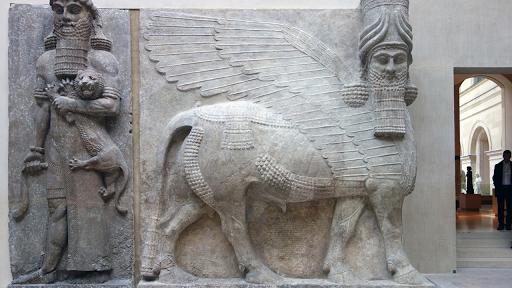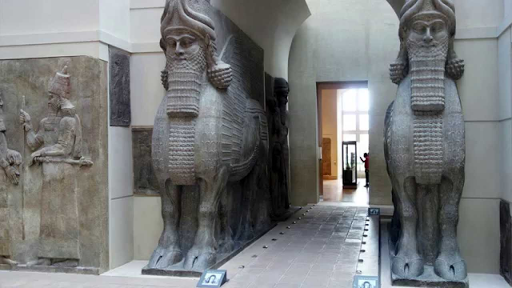Where were the lamassu sculptures originally displayed. For this reason it is not an entirely freestanding sculpture.

Lamassu Backstory Article Assyrian Khan Academy
The most famous colossal statues of Lamassu have been excavated at the sites of the Assyrian capitals created by King Assurnasirpal II reigned 883 859 BC and King Sargon II reigned 721 705 BC.

. Where were the lamassu sculptures originally displayed. Most of todays Assyrians have a sculpture of Lamassu in their You May Also Find These Documents Helpful. Lamassu the were.
What ethnic group is credited with the first system of writing known to man. Originally unearthed in Rome and displayed in the Borghese Gallery it was sold to the occupying French and now sits in the Louvre. In some cases the lamassu statues were accompanied by.
The Lamassu served as the symbolic protector of a kings palace and where prominent in Assyrian architecture in the 800s and 700s BCE. The most famous colossal statues of Lamassu have been excavated at the sites of the Assyrian capitals established by King Assurnasirpal II reigned 883 859 BCE and King Sargon II reigned 721 705 BCE. However it is displayed in a museum in its original context a lamassu is the guardian of a doorway integral with a wall.
In the Assyrian mythology there were human headed winged bullslions that were protective genies. There is no historical evidence showing that Lamassu was worshipped as a god. Then in April 1991 Michael Bourbon master conservator from Paris arrived in Chicago to create a silicone and plaster cast of the lamassu.
Where were the Lamassu sculptures originally displayed. This motif is common in the Near East and dates to 3000 BCE. What ethnic group is credited with the first system of writing known to man.
The first change was the capital was moved to Dur Sharrukin present day Khorsabad and second the Lamassu was presented on a bulls body compared to a lions and seems to be slightly smiling. Strengthening these bonds further were the so-called Panhellenic sanctuaries and festivals that embraced all Greeks and encouraged interaction competition and exchange for example the Olympics which were held at the Panhellenic. Looking up the lamassu that have been displayed in the.
Displayed originally where. 721-705 in Dur-Sharrukin present d-y Khorsabad. Which work has a king approaching the god Shamash.
What color is lapis lazuli. The Assyrians envisioned a protective spirit that was part bull and part human and sometimes part eagle. A Sargons palace b Gudeas Lagash c Ashurbanipals palace d Ziggurat at Ur Which of the following played an important role in the shaping of modern art.
Landscape online textbook the. Other figures were also discovered having similar features such as wearing a ruffled dress having a horned tiara and arms raised up to the sky. Furthermore where were the lamassu sculptures originally displayed.
Lamassu in Mesopotamian Art and Architecture Human-headed winged bulls from Sargon IIs palace in Dur-Sharrukin modern Khorsabad Louvre Resembling a sphynx or griffin Lamassu has the body of a bull or lion with the head of a human and eagle-like wings. Where is the Lamassu. Which work has a king approaching the god.
What were the most common themes in Assyrian art. The lamassu in museums today including the Louvre shown in our video as well the British Museum The Metropolitan Museum of Art and National Museum of Iraq in Baghdad and others came from various ancient Assyrian sites located in modern-day Iraq. These statues in particular were discovered in the palace of Sargon II r.
They were represented as double-aspect figures on corners in. The lamassu of Ashurnasirpals Northwest palace were enormous stone-carved sculptures with the head of a human and displayed animal-like features including the wings of a bird and the body of a bull. A replica of Chicagos bull was made and displayed at.
From the ninth to the seventh century BC the kings of Assyria ruled over a vast Written By whitehouse March 07 2022 Add Comment Edit. The Lamassu sculptures were recovered from where. Indeed most of the sculptures were placed at gateways palaces underneath the houses and not in the temples.
Ashurnasirpal Essay 1619 Words 7 Pages. Lamassu were placed on either side of the doorways of Assyrian palaces and of gateways to cities to protect against evil spirits and impress the neighbors. Lamassu was like a mediating goddess between the other deities.
And the lamassu which were thought of as protective deities stood guard either side of an entrance way. Chicagos bull seems to have been on display undisturbed since 1931. Assyrian sculpture typically placed prominent pairs of lamassu at entrances in palaces facing the street and also internal courtyards.
The Lamassu sculptures were recovered from where. The Ziggurat at Ur was a fortress funerary monument palace temple platform Where were the Lamassu sculptures originally displayed. The palace stood pairs of powerful mythological creatures known as lamassu Gates 170-171.
From what we can tell it seems that these sculptures were believed to protect the palace and king from evil supernatural forces as well. The Assyrians came first. The winged beasts from Nimrud in Iraq the ancient city of Kalhu also became quite famous when Lamassu there were ruined in 2015.
A figure of this goddess was unearthed at Uruk in Mesopotamia and she was labeled as Lamma. The cultural landscape online textbook. Hermaphroditus was actually a popular subject of paintings and statuary even if Written By whitehouse March 11 2022 Add Comment Edit.
Colossal Lamassu Sculpture From The Palace Of Sargon Ii At Khorsabad Sargon Ii Google Arts Culture

Lamassu From The Citadel Of Sargon Ii Video Khan Academy

Lamassu Symbol For Protection Indrosphere

25 Lamassu From The Citadel Of Sargon Ii Dur Sharrukin Modern Iraq Ap Art History
Human Headed Winged Lion Lamassu Assyrian Neo Assyrian The Metropolitan Museum Of Art

Lamassu Backstory Article Assyrian Khan Academy
Human Headed Winged Bull Lamassu Assyrian Neo Assyrian The Metropolitan Museum Of Art

0 comments
Post a Comment